Every copy writer I’ve worked with has experienced writer’s block.
No matter how creative you think you are, there will come a time when you hit a brick wall and your creative juices stop flowing.
You run dry — now what?
I know people who have been writing PPC ads for many years for the same industry.
They’ve tried every phrase, every value proposition, and combinations — yet campaign performance plateaus.
A good ad copy can make a big difference in the performance of your campaign.
PPC Ad Copy Format
Before you start diving in and letting your creative juices flow, it’s important to understand Google Ad’s text ad format.
Here’s a nice example of a Google PPC text ad:
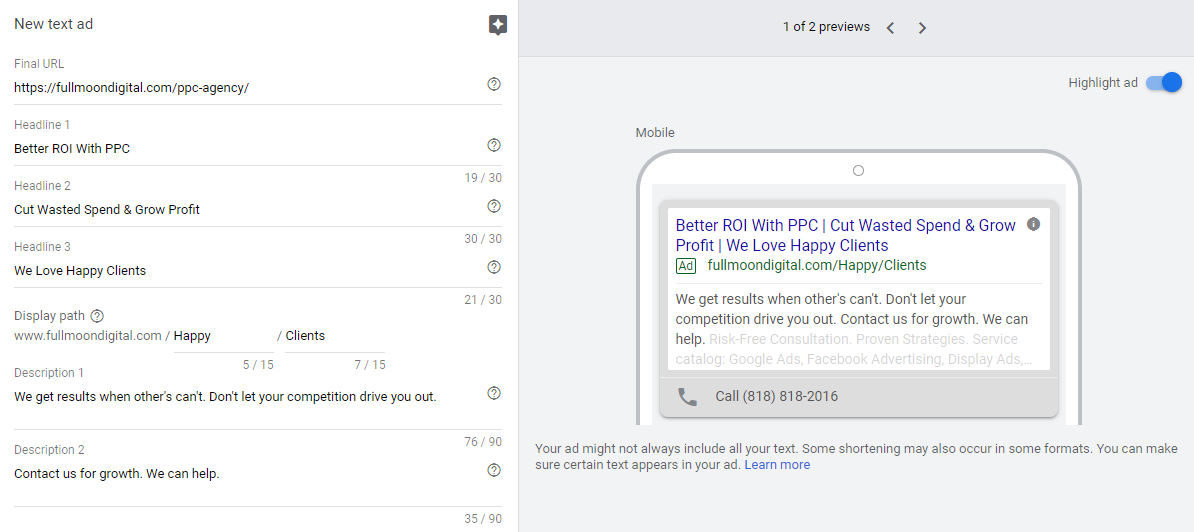
As you can see in the screenshot, your headline 1, headline 2, and headline 3 makes up majority of your ad. Plus they are in hyperlink blue because they are clickable.
The Final URL is displayed below the headlines to show where the user which page the user will be click to (most likely).
Finally you have the description line 1 and 2 where you give the user more details into your offer with up to 90 characters each. Now that’s a lot to talk about!
Writing Your Ad Copy
As a result, well-written ad copy can increase the clicks and bring more qualified visitors to your website; ultimately increasing conversions. Today, we are going to look at actionable pay-per-click ad copy tactics that can help you improve your traffic and sales. Besides ad copy, there are many PPC mistakes you can avoid to make sure you avoid to keep your ROAS healthy.
Re-energize your ad copy; breathe new life into your ad messaging
Here are some things that can help you put a fresh perspective on your ad copy — perhaps even increase your campaign performance.
Let’s dive into these PPC ad copy tips
PPC ad copy Tip #1
Match your ad copy to your customers buying cycle.
Whether they are researching, considering, or ready to take action — customizing your ad copy with the right keywords will increase the likelihood of getting the right people to click on your ad.
If people are searching for “what’s my house worth,” then your ad copy should be tailored around that search phrase.
Someone searching for that phrase is most likely to either refinance or sell their home.
For example, your ad copy headline could read like this:
Refi or Selling? Find Out What Your Home Is Worth
or
Free Home Value Assessment | Get a Free Comprehensive Report
You can expect a higher click-through-rate (CTR) because by writing your ad to be specific, you are speaking directly to meet the needs of the searcher.
PPC ad copy Tip #2
Let your audience self-qualify before they click.
If you are selling a high-priced premium product or service, it can help you from getting too many unqualified clicks by including your price in the ad copy.
This will help you pre-qualify your visitors. They won’t be shocked with the sticker price on the actual landing page.
Whether your objective is to use PPC to drive more in-store traffic, get more online leads, or drive more eCommerce sales, the best tactic is to give your prospect the opportunity to raise their hand and show interest before they click on your PPC ads.
Setting this expectation is considered a good user experience — it also creates transparency between you and the prospect.
Any leads or prospect who is not serious about what you’re selling will most likely avoid clicking on your ad — so you end up only attracting visitors that understand your value and ready to pay for it.
The worse thing is to have people go to your website and then getting scared away by your price, product, or experience.
Don’t add extra pain to your visitors by shocking them on your landing page.
You can close the gap and generate higher interest click by:
#1: Disclosing your price in your PPC ad copy can avoid this friction.
#2: Ensuring continuity between your ad copy and landing page. This just means whatever your ad copy is talking about should be mirrored on your landing page.
#3: Adding your value proposition in your pay-per-click ad copy. We’ve seen our fair share of ad copy that try to be fancy; using “big words” — and they never work. Get straight to the point. Tell your prospects what you are offering them. Get that click.
PPC ad copy Tip #3
Be geographically relevant to your audience.
You can target your PPC campaigns down to the city level — so it’s a great advantage to use location in your ad copy.
Local ads resonates better with your visitors — when they recognize the city they are searching in.
Here’s an example for corporate catering in Los Angeles.
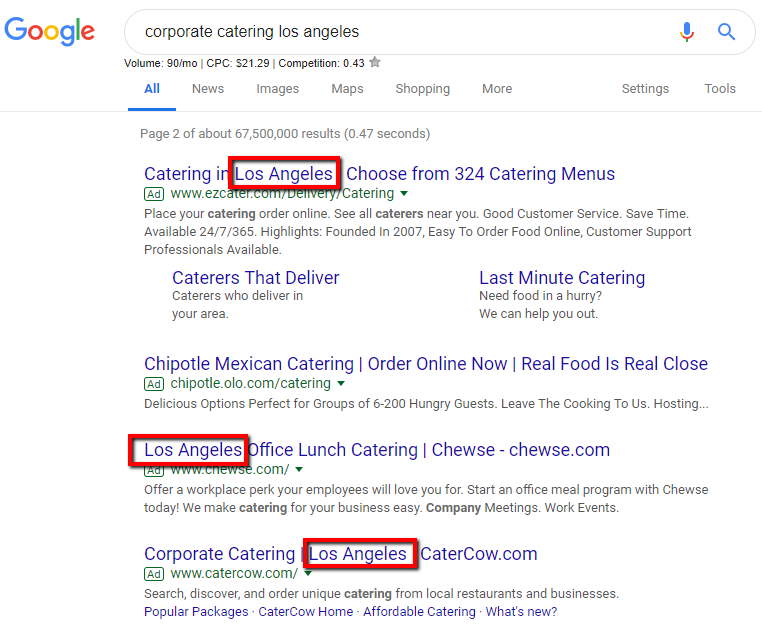
Three of four brands took the extra effort to customize their ad copy to include Los Angeles, and will be the business to collect more granular campaign data.
Chipotle is quite a shock to be honest.
Not only their ad missed the opportunity to be locally relevant, they are also not leveraging Google Ads ad extensions to maximize the campaign’s performance.
In fact, one of the biggest ad extension all four ads are missing is the Call Extension.
PPC ad copy Tip #4
Use the search phrase in your ad copy headline.
When a searcher sees the search term in the ad copy, they are more likely to click through to your landing page.
Your headline is the most prominent part of your ad copy. It is bolded and bigger font size than the description below.
You have two choices here; either create single keyword ad groups (SKAGs) or use dynamic keyword insertion (DKI).
When you create SKAGs, you can create specific headlines because you are, essentially, only bidding on one search phrase.
An advanced tactic PPC marketers use is DKI. Your ad will automatically create your headline with the search term used by the searcher.
A word of caution when using DKI. You must be careful with the search phrases you’re bidding on. If mismanaged, you could have really strange looking headlines that lose its relevance.
PPC ad copy Tip #5
FOMO can be your best ally.
Now, before you go and create ad copy with chalk full of “fear-of-missing-out” language, remember how influencers abused FOMO and what it did to the Fyre Festival.
Ok, now that you understand that you have an accountability to implementing FOMO tactics, let’s go on.
Best situations to appeal to FOMO in your PPC ad copy are when you have sales, seasonal offers, promotions or exclusives.
A few examples include:
“Limited Time Offer”
“Sale Ends in X Days”
“Exclusive Online Offer”
“Limited Quantity In Stock”
“Hurry Before We Run Out”
You get the idea. There are endless ways to create FOMO in your ad copy headline — limited by your creativity.
The whole point is to get your visitors to act immediately, click, and make the purchase right away.
PPC ad copy Tip #6
Match your ad with your landing page.
This sounds straightforward, but it’s a huge miss for many brands who have hundreds to thousands of simultaneous ads running.
Don’t take your visitors for fools — it will be your biggest mistake.
Continuity from your ads to your landing page goes beyond the basic PPC strategy — it crosses over to conversion rate optimization (CRO) as well. But that’s another topic.
The rule of thumb is to keep your message consistent and flowing from your ad to your landing page.
If you offer free shipping in your ad copy, offer free shipping on your landing page.
When you’re running a discount in your ad copy, then make sure you send visitors to a landing page offering the discount.
If you offer a free service in your ad, don’t just offer a free trial.
PPC ad copy Tip #7
Asking searches a question.
Using question concept that speaks to “How, What, Who, Where, When” can help your ad copy guide your visitor to the answer.
Leading with a question, and then providing the solution is a great way to attract visitors to your landing page.
Use this sparingly.
Asking questions can also go the other way — confusing the searcher if you’re unable to satisfactorily answer their question.
Your questions should address a pain point, whatever that is for the industry you are in.
Here are a few examples of leading questions:
Law firm: “Need a Winning Attorney on Your Side?”
Diet products: “Can’t lose the weight you want?”
DIYer: “How to build a doghouse”
Automotive: “Want more power for your diesel truck?”
Guide your visitors with questions, and as long as you provide relevant answers on your landing page, you will see increased engagement and conversions.
PPC ad copy Tip #8
Responsive search ads (currently in beta as of this article).
Over 40,000 possible combinations that automatically adapt to show ads to your customers.
As you can imagine, this can be very powerful. With Google Ads’ ability to automatically test, optimize, and serve the best performing ad to your visitors changes the game for my advertisers.
According to Google Ads,
Assets can be shown in any order, so make sure that they make sense individually or in combination, and don’t violate our policies or local law.
For a single ad, you can create variations of headlines and descriptions.
Google will mix and match your headlines and descriptions up — test variations of it with the goal of finding the best and serving that to your visitors.
Create as many headlines as you want, up to 15, and make sure your headlines are unique enough — as it plays into your ads’ strength.
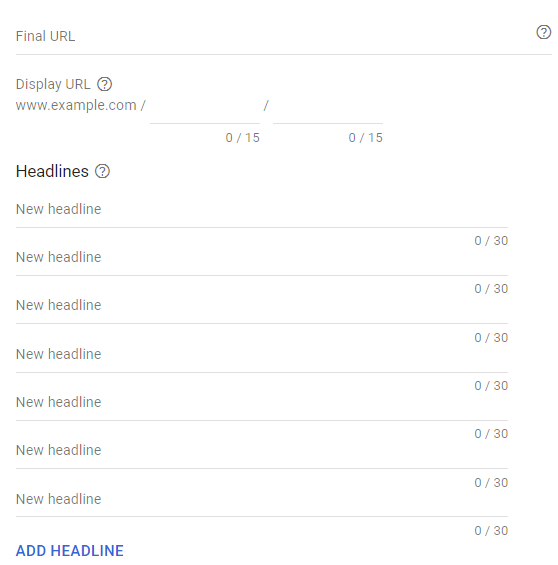
These descriptions will be used as your D1 and D2; again mixed and matched by Google’s AI.
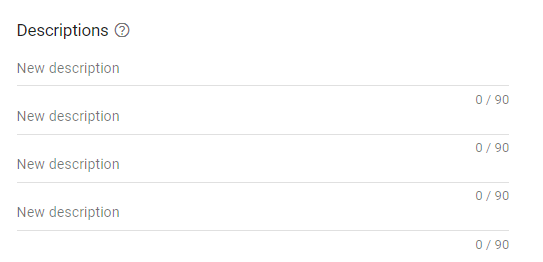
This is a simple monitor that tells you if your ad headlines and description have met Google’s minimum requirements for its RSAs.
Just because you have completed the elements, there is still no guarantee that your ads will drive the results you want.
As an advertiser, it is still your responsibility to monitor the performance and results of your RSAs.
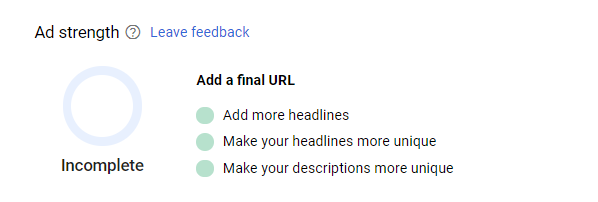
PPC ad copy Tip #9
Focus on your customer, not yourself.
“We,” “I,” “Me,” “Us,” and “Myself” are words that you should prohibit in all your ad copy.
Research has found that referring to yourself turns people away — they don’t care about what you think about yourself. They care about how you can help them.
After all, whatever you are selling should be solving problems.
“We can help you find the car you want.” will get fewer clicks than “Trade in and get into a new car today.“
By focusing on your customers, you message will appeal to their needs, offer to improve their lives, and give them a much better experience.
PPC ad copy Tip #10
Be concise and specific.
In Google Ads, you have 30-character limit in headline 1, 2, 3, and a 90-character limit in description line 1 and 2.
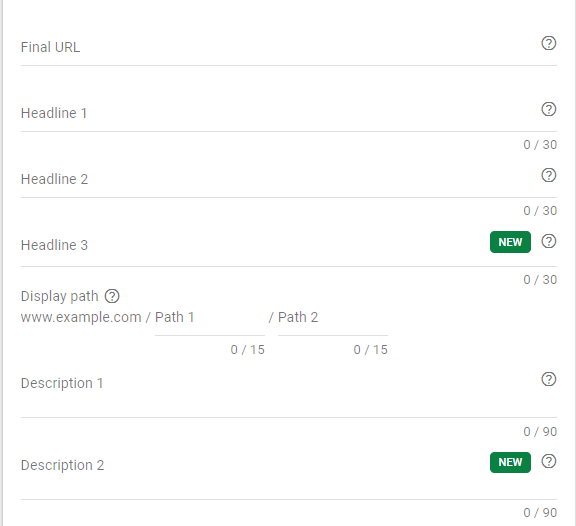
Compared to the old format where you only had 35-character limit each in description line 1 and line 2, and a 25-character limit in the headline.
Google Ads’ new ad format allows for more characters but that still requires you to practice diligence with concise messaging.
Get to the point and be precise in your messaging to help your audience understand your offer.
PPC ad copy Tip #11
Use your keywords in the URL display path.
By including your keywords in your ad’s display path, you’ll stand out and appear more relevant.
It’s also another chance to flash your keyword.
This reinforces familiarity and relevance to what your visitor is searching for.
The more specific you are in giving your visitors what they’re looking for, the better.
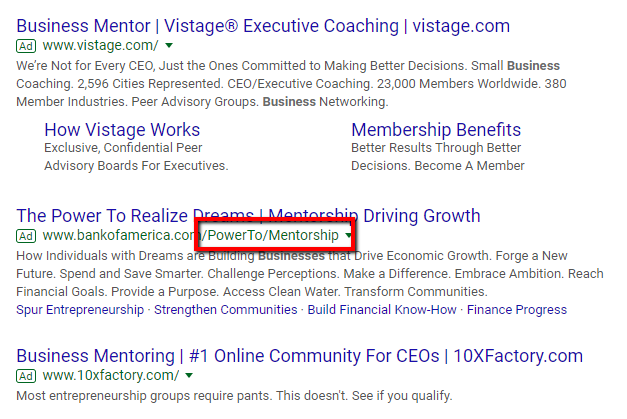
Yelp and GotPrint stands by using keywords in their display path.
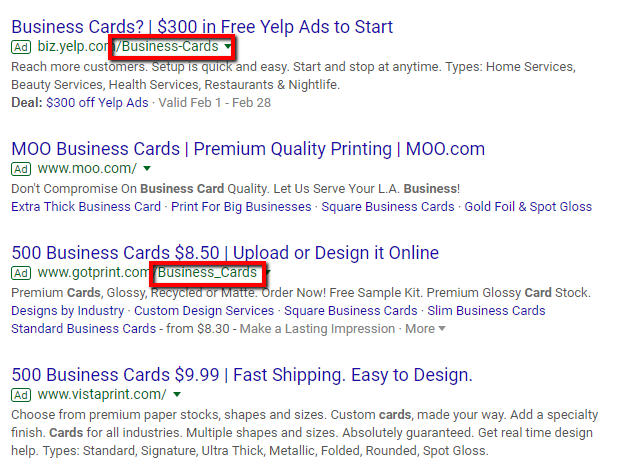
Wrapping It Up
To continue improving your PPC performance, you can start incorporating these things into your ad copy, test, and then improve.
A/B test, experiment and split test your ad copy, headlines, your price options.
Test all of it so you don’t miss out on the ideal versions of your PPC ad copy.

